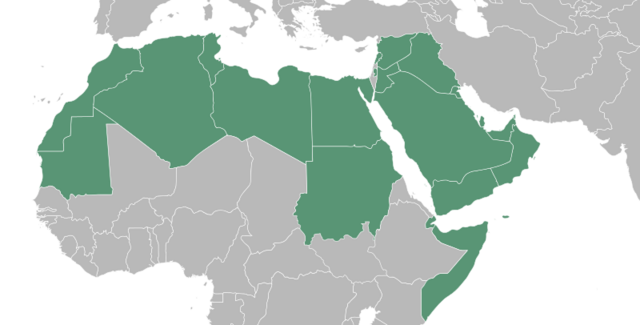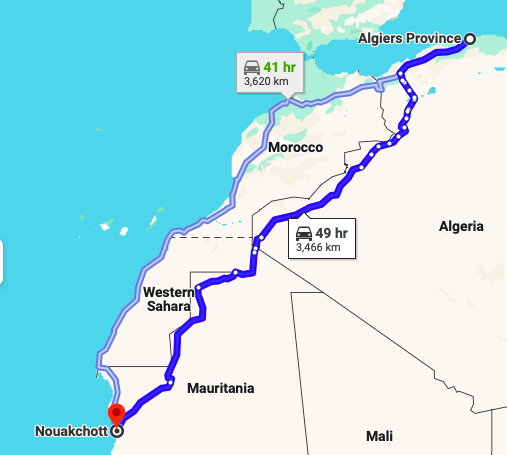Is Road Tripping Across the Arab World Possible?

By: Joud Sleilaty / Arab America Contributing Writer
Introduction
You’ve likely come across stories about backpacking adventures across Europe or summer tales of people who chose to discover East and South Asia. Journeying through Latin America has also become increasingly popular these past few years, and most famous is the iconic road trip from California to New York which captures the American imagination. But, have you ever heard a road trip story of someone traveling across the Arab world? With just over 22 Arab states, the prospect seems plausible in theory. However, it is undeniable that the region these states lie in is one of the most dangerous regions in the world. So is the idea of road-tripping across the Arab world an unattainable dream, or could it happen?
Has the Trip ever been Executed?
The trip has indeed been executed before, by both international and local travelers. However, as times are constantly changing, with new conflicts emerging in the Arab world, there are frequent adjustments to restrictions and regulations. Moreover, most individuals who embark on an Arab world trip tend to opt for air travel over traveling by car or bus for safety and comfort reasons.
1st Part: Arab Africa
Let’s kick-off our potential trip in Morocco, exploring some of North Africa’s iconic cities like Marrakech, Casablanca, or Rabat’s capital. Morocco shares a border with Mauritania, separated by the Western Sahara. While traveling through the Western Sahara is feasible, it’s not recommended for solo travelers due to safety concerns. The area is known for landmines, bandits, and false guides so passing through this buffer zone is not recommended (Wikivoyage) (Travel.gc.ca). However, according to Spirit Travelers, the insecurity of the “No-Man’s Land” strip is often exaggerated. If you decide to proceed, bus services and shared taxis can take you from border towns like Boujdour, Laayoune, and Dakhla into Mauritania’s capital, Nouakchott, for only 470 MAD (Spirit Travelers).
From Nouakchott, you can travel to Algiers, the capital of Algeria, by flight or by driving. The driving distance is approximately 2075 miles, taking around 2 days and 21 hours (Rome2rio). While border crossings between Algeria and Tunisia have been on again off again over the years, since 2022, all Algerian borders except Tunisia are closed or inaccessible to foreign tourists, making this border crossing possible in our journey (Sahara Overland).

Despite Libya’s beauty and renowned hospitality, Western governments advise against travel to the country due to the armed conflict that has been ongoing since 2011, although a ceasefire was reached in 2020 (U.S. Department of State – Travel Advisories for Libya). However, with good planning and thorough research, traveling to Libya safely is feasible. Tourists can visit Libya, but visas are only valid for travel in the Western part of the country. To obtain a visa, travelers must first secure a Letter of Invitation from an authorized Libya-based company, typically by booking a full tour. Solo travel in Libya is not permitted, and visitors must always remain accompanied by a guide. Travelers can reach Libya by flying from Tunis to Mitiga International Airport, or alternatively, buses are available and crossing by foot is always an option, but visitors must be picked up by their tour guide upon arrival (Against the Compass – Travel to Libya)
According to Against the Compass, a road trip from Libya to Egypt is currently not feasible due to the closed border (Against the Compass – Travel to Libya). However, recent plans to open the Sallum border for trade between Egypt and Libya have been discussed, although no mention has been made regarding border crossings for individuals. Alternatively, there is a direct 2-hour and 50-minute flight available from Tripoli to Cairo (Expedia).

2nd Part: The Levant
Egypt is a crucial link between the Arab world in Africa and the Arab world in Asia, renowned for its rich history, beautiful cities, beaches, and deserts, making it one of the most visited Arab countries. However, due to the current situation in Gaza, traveling to our first Asian Arab country, Palestine, is not feasible at the moment. Our next country would therefore be Jordan. Israel acts as a barrier between Egypt and Jordan. To avoid entering Israel, which could result in having Israeli stamps on passports, travelers can choose to take a ferry in the Red Sea from Egypt to Jordan, providing future access to Lebanon without encountering any major issues. Driving through Syria to Lebanon would take less than a day from Jordan. The borders along this route are mostly open and safe, as it is a common trajectory for many travelers daily. Driving from Syria to Iraq is our next step in this Arab World Roadtrip. An over 8-hour route is available, but flights are also an option for travelers seeking a quicker journey. However, it’s important to note that both countries are advised against travel by the US government due to safety concerns. Despite this, Syria and Iraq boast beautiful scenery and remarkable people, making them destinations not to be missed.
3rd Part: The Gulf
Traveling across the Gulf should be relatively straightforward. These countries are known for their safety and modern infrastructure. The Gulf nations are highly interconnected, making transportation between them convenient. Flights are readily available, offering quick and efficient travel options. Additionally, traveling by car or bus is also feasible, with well-maintained road networks and efficient public transportation systems. There is so much to see in the Gulf; it should be a blast for tourists. Overall, exploring the Gulf countries promises a smooth and enjoyable experience.
4th Part: Remaining Countries
Don’t worry, we haven’t forgotten about the remaining countries. Flights to Somalia and neighboring Djibouti, as are flights to Yemen, are readily available, although travelers should be mindful of tensions with Saudi Arabia. Sudan can be accessed through Egypt, but flight options are available. Finally, flights to the Comoros Islands, considered safe, are also available for travelers.
Additional Information
In planning your trip, it’s crucial to consider several important factors.
- Be mindful of the currencies used in the countries you’ll be visiting, and ensure you have the appropriate currency or access to currency exchange services.
- Visa requirements vary between nations, so research and obtain the necessary visas well before your journey. Not all countries will allow you to issue a visa on arrival.
- Familiarize yourself with the rules and laws of each country you’ll be visiting, including local customs and cultural norms, to ensure you stay safe and respectful throughout your travels.
- Be aware of any safety advisories or travel warnings issued by your government for the regions you plan to visit.
- Avoid unsafe areas and always stay with a local if traveling through countries with tensions or conflicts.
- Be cautious about the potential implications of an Israeli stamp on your passport, as it may restrict entry to certain countries in the region.
- Consider the types of food and medications that can or cannot be brought into each country, as regulations may vary.
- Respect cultural norms regarding dress codes, particularly in conservative regions, to avoid causing offense or discomfort.
- Learn some Arabic or have a translator with you at all times.
- Finally, consider your communication needs and research phone plan options that offer international coverage and data roaming to stay connected during your travels.
By carefully considering these factors, you can ensure a smooth and enjoyable journey through the Arab world.
Check out Arab America’s blog here!


